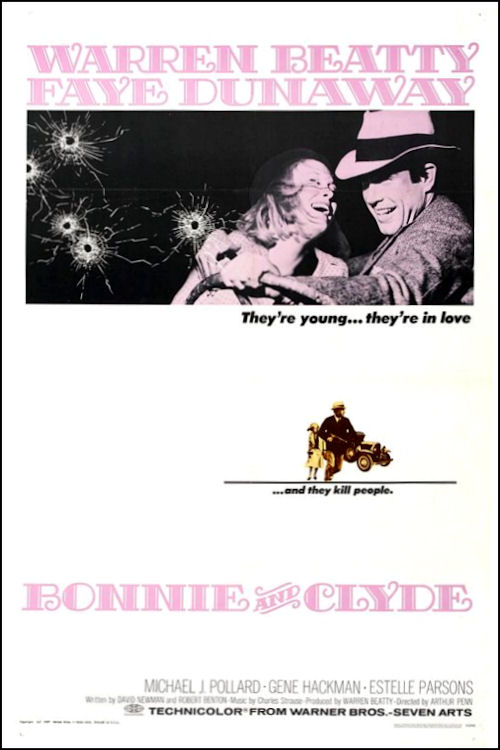Anthony's Film Review
Bonnie and Clyde (1967)

This classic drama is thrilling, and it pushed the envelope for future movie violence...
Like many people, I grew up in the last part of the 20th century, an era where it's typical for movie violence to range from mild to very graphic. I often relied on the Motion Picture Association of America's R rating to tell me if a violent movie was going to be very violent. After many years, I became curious about the history of movie violence. I knew that movie violence in the early 20th century was generally nowhere close to the intensity of violence in much later movies. But at what point along the movie history timeline can one separate the era of relatively tame movie violence and the new era of more intense violence? Movie historians will no doubt provide a much better answer than I, but for now, I will say that one film could be a candidate for being groundbreaking in movie violence: Bonnie and Clyde in 1967.
If you know the real story of Bonnie Parker and Clyde Barrow, the robber couple during the Great Depression, you will recall the manner in which they met their untimely deaths on May 23, 1934. Basically, the two were killed by gunfire in a police ambush, but it wasn't a few bullets. It was over a hundred rounds. Imagine getting killed by just the first couple of bullets, then still getting pummeled by gunfire as a corpse. Well, that's the final scene in the 1967 movie Bonnie and Clyde, starring Warren Beatty as Clyde Barrow and Faye Dunaway as Bonnie Parker. While researching the history of movie violence, I came across a clip of that scene from the movie and was stunned by it. If I were watching it back in the late 1960s, I'd be shocked too.
Eventually, in August 2017, Bonnie and Clyde was re-released in theaters to celebrate its 50th anniversary, and I gladly paid $12 to see it. I was definitely drawn in from the start. The opening credits have a creative way of displaying old photographs as a way to introduce the characters. Then, in the first scene where Bonnie meets Clyde for the first time, I was taken by how the two stars play their characters in the film. Beatty portrays Clyde with a mix of charm and a hint of excitement, while Dunaway plays Bonnie as a young woman who is bored and looking for a new adventure. You can practically sense the chemistry between the two from the start.
Yet, these two characters are somewhat more complex than you'd expect. For one thing, Bonnie and Clyde are each attracted to the other, but not necessarily to the same degree. Bonnie is more eager to engage in lovemaking with Clyde, who seems more detached with that sort of thing, even if he may find her to be a pretty gal. Also, Bonnie does have family whom she still cares about: her mother back home in Texas. At one point, she attempts to flee from Clyde in an effort to return home. But in the end, the thrill of a robbery spree seems to have ultimately won out.
Across several states in the central and southern parts of the U.S., Bonnie and Clyde engage in various small-scale robberies, hitting little banks and grocery stores and stealing people's cars along the way to evade the police. These illegal jobs aren't an everyday thing, as the movie alternates between a crime drama and a human drama, with maybe one-third of the movie or so dedicated to the heists and murders that occur. Also, in order to stay ahead in the string of crimes, Bonnie and Clyde form a robbery gang after enlisting Clyde's brother Buck (played by Gene Hackman), Buck's wife Blanche (played by Estelle Parsons), and a mechanic named C.W. Moss (played by Michael J. Pollard). At one point, a young couple played by Gene Wilder and Evans Evans ride along, but only for a short time before getting kicked out.
The five members of the Barrow gang make the story even more intriguing than if it was just Bonnie and Clyde working as a pair. There are interesting dynamics when Buck gladly participates in the crime spree while Blanche is the cowardly one who feels terrified and stuck. There's also a scene where C.W. admits to his father that he is riding along with Bonnie and Clyde and the father is displeased by this. All of this is happening as the action sequences in this movie get increasingly intense. Early scenes may show a couple of shots from handguns and nothing more, but later on, there are scenes of all-out gunfights where the police appear to be much closer to apprehending, or killing, the Barrow gang. (Obviously, as I mentioned already, the police are eventually successful.)
Bonnie and Clyde is a film that has a lot going for it. As a crime drama, there is a great sense of escalating and explosive tension. As a human drama, we get to see who the characters really are and how they interact in harmony or in conflict. These two components work well not only individually, but also when they intertwine. It's like alternating your attention between two separate strands of yarn before noticing that they are soon twisting around each other repeatedly and forming one strand. Best of all, it's based on a true story. It's one of those movies that make you curious about the real-life people it's based on. Bonnie and Clyde are definitely legendary, both in the world of crime and in the world of cinema.
Anthony's Rating:










For more information about Bonnie and Clyde, visit the Internet Movie Database.
Home
Film Reviews
Other Reviews
Commentaries
Links
About AFR
RSS Feed
Privacy Policy
E-mail Anthony











